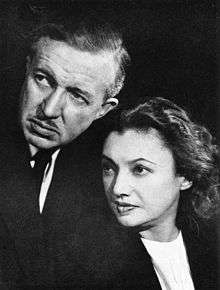Lavender marriage

Lavender marriage is the popular term used to describe a male-female marriage in which one or both of the partners was homosexual–or possibly bisexual. The more general term is mixed-orientation marriage. It is a specialized instance of a marriage of convenience, in which the marriage is formed for some reason other than the romantic attachment assumed to be the basis of modern marriages, for legal reasons involving inheritance or immigration, for example.
The partners in a lavender marriage were concealing the fact that the sexual orientation of at least one of them was not primarily heterosexual. The term lavender marriage dates from the early twentieth century and is used almost exclusively to characterize certain marriages of public celebrities in the first half of the twentieth century, primarily before World War II. At the time, public attitudes toward homosexuality made it impossible for a person to pursue a public career, notably in the Hollywood film industry, while acknowledging homosexuality.[1] One of the earliest uses of the phrase appeared in the British press in 1895 when lavender was associated with homosexuality.[2]
Usage
With the inclusion of morality clauses in the contracts of Hollywood actors in the 1920s, some closeted stars contracted marriages of convenience to protect their public reputations and preserve their careers. A noteworthy exception that demonstrated the precarious position of the public homosexual was that of William Haines, who brought his career to a sudden end at the age of 35. He refused to end his relationship with his male partner Jimmy Shields and enter into a marriage at the direction of his studio employer Metro-Goldwyn-Mayer.[3] The term lavender marriage has been used to characterize these couples/individuals:
- The 1923 marriage of Rudolph Valentino with lesbian costume and set designer Natacha Rambova, disguising her relationship with actress Alla Nazimova.[4]
- The English broadcaster and journalist Nancy Spain considered entering a lavender marriage to disguise her relationship with Joan Werner Laurie, a magazine and book editor.[5]
- The marriage of Robert Taylor and Barbara Stanwyck supposedly disguised her putative bisexuality and has been characterized as lavender for that reason, but it was prompted by the need to protect both their reputations after a Photoplay magazine article reported they had been living together for years while unmarried.[6]
- Actor Rock Hudson, troubled by rumors that Confidential magazine was planning to expose his homosexuality, married Phyllis Gates, a young woman employed by his agent, in 1955.[7]
- The term has been applied to the marriage of Tyrone Power and French actress Annabella in 1939, though both appear to have been heterosexual.[8]
- American theater actress and producer Katharine Cornell married theater director Guthrie McClintic in 1921. She appeared only in productions he directed, and they lived together in their Manhattan townhouse until his death in 1961.[9]
- Swedish Hollywood actor Nils Asther and vaudeville entertainer Vivian Duncan had a brief marriage of convenience that resulted in one child. Nils Asther was a well known homosexual who had a relationship with actor/stuntman Kenneth DuMain.[10]
See also
References
- ↑ Claude J. Summers, The Queer Encyclopedia of Film & Television (Cleis Press, 2005), p. 132
- ↑ Lyttle, John (August 29, 1995). "The bride and groom wore lavender". The Independent (UK). Retrieved January 18, 2015.
- ↑ Trimmier, Benjamin. "Haines, William "Billy" (1900-1973)". glbtq.com. Retrieved April 28, 2007.
- ↑ Norton, Richard (1997). The Myth of the Modern Homosexual: Queer History and the Search for Cultural Unity. Casell. p. 57. Retrieved January 18, 2015.
- ↑ Collis, Rose (1997). A Trouser-wearing Character: The Life and Times of Nancy Spain. Casell. p. 251. Retrieved January 18, 2015.
- ↑ Wayne, Jane Ellen (2004). "lavender+marriage"+"robert+taylor"& The Leading Men of MGM. Carroll & Graf. p. xv. Retrieved January 18, 2015.
- ↑ Bret, David (2004). "lavender+marriage"& Rock Hudson. Robson Books. p. 121.
- ↑ Bret, David (2000). "lavender+marriage"& Errol Flynn: Satan's Angel. Robson Book. p. 79. Retrieved January 18, 2015.
- ↑ Mosel, Leading Lady: The World and Theatre of Katharine Cornell, Little, Brown & Co, 1978.
- ↑ Nils Asther memoirs "Narrens väg - Ingen gudasaga" Published 1988, Sweden